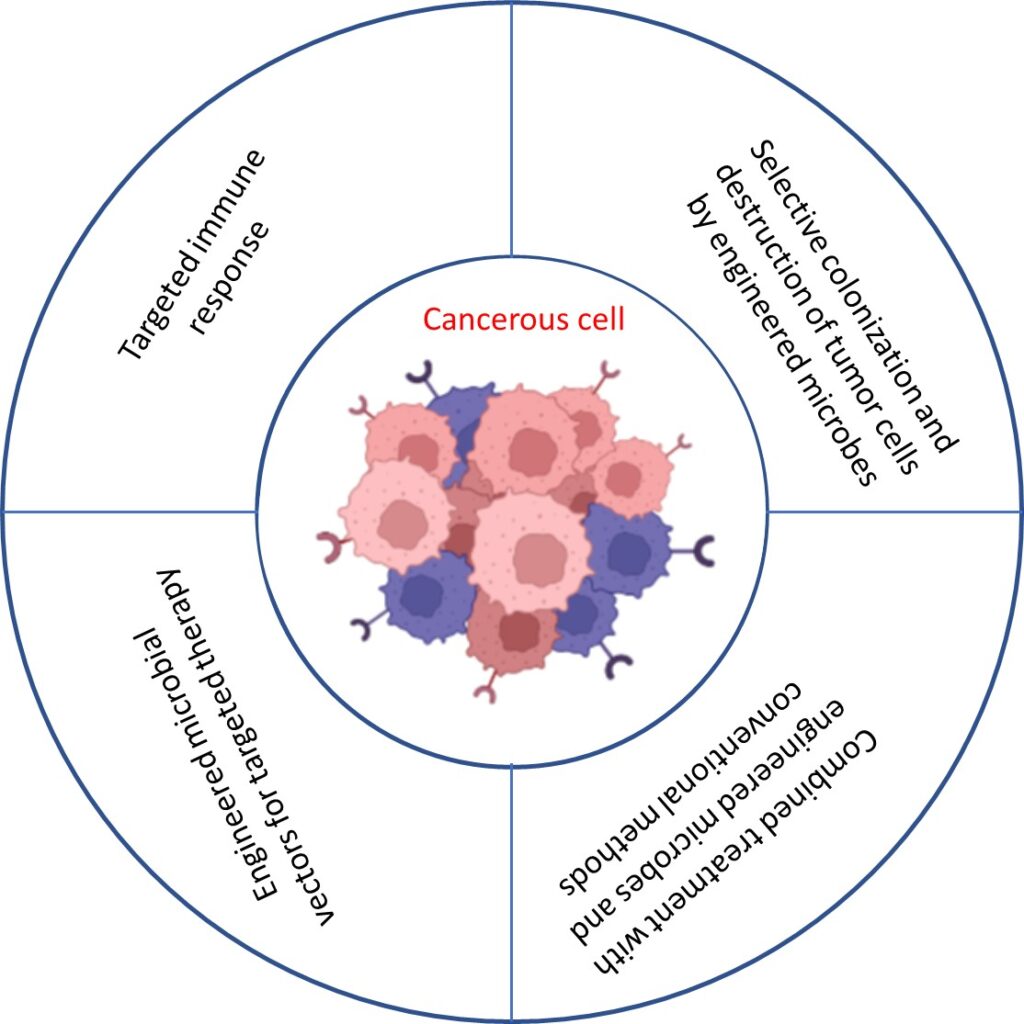Designer Therapeutics
May 1, 2023
A diverse community of trillions of commensal microorganisms reside in us, humans. Carefully molded communication between the commensal microbiota and our immune system controls tissue homeostasis. For e.g.: T-cells and B-cells have phenotypes and functions that are influenced by microbiota. These cells suppress responses to harmless antigens and enforce the integrity of the anatomical barriers like skin or the gut mucosal barrier.1 Can these interactions be tailored to help us treat diseases? Can symbionts be engineered to prime immunity against selected targets?
Genomes of certain skin commensals have been engineered with the goal of preventing or treating cancer and have been shown to work in mice. Harnessing microbes for cancer therapeutics and potentially treatment of other diseases is an exciting avenue in the field of microbiome research.

Figure 1. Subset of mechanisms by which microbes can be used as therapeutics.
Created in BioRender.com
Most microbiome research has focused on the microbial ecosystems of the human gut. However, there is an entire community that lives on the skin, in the armpit and in other tissues of the human body and our symbiotic relationship possibly produces beneficial secretions that appear to protect us from infections. In addition, they appear to modulate our immune system and can amplify or abbreviate our immune response to potentially harmful agents – be it a harmful microorganism, a tumor or something else less harmful.
Recently, Fischbach and his team created an immunotherapy for treating aggressive melanoma in mice by harnessing the skin’s response to bacteria2. They genetically engineered a bacterium, Staphylococcus epidermidis, to produce a tumor antigen. Following application of live cultures of the modified S. epidermidis to the fur of diseased mice, a strong immune response was observed. The treated mice developed tumors much more slowly and some did not develop tumors at all. In the case of mice with metastasis to the lungs, treatment with the engineered bacteria significantly improved survival by either eliminating the tumors or by drastically shrinking the size of the tumors. In combination with “checkpoint blockade” 3, established tumors disappeared in 15/16 subjects and evidence of a memory immune response was observed. And it was able to do all of this without causing an inflammatory response.
It is true that animal models don’t always translate to humans but there are reasons to be hopeful. S. epidermidis has been previously shown to induce a similar CD 8 T-cell response in primates as it does in mice4. Also, as a skin commensal, an engineered S. epidermidis will efficiently colonize human skin and could serve as self-regenerating cancer therapeutics.
Even though the concept of using microbes as cancer therapeutics originated toward the end of the 19th century, advances in molecular biology have allowed an explosion in the research and exploration of this concept. Engineered bacteria have been shown to act as anti-tumor agents either alone or in combination with conventional methods5. A probiotic bacterium, Escherichia coli Nissle 1917 (EcN) was used for selective delivery of a cytotoxic protein (HlyE) against colorectal cancer6.
In the field of cancer therapeutics, engineered microbes could be the ideal carriers for targeted cancer therapy. Applications of advances in the field of molecular biology and molecular engineering appear to be a promising way to develop targeted antitumor therapeutics with increased efficacy and decreased adverse effects.
- https://pubmed.ncbi.nlm.nih.gov/27383982/
- https://med.stanford.edu/news/all-news/2023/04/cancer-bacteria.html
- https://www.cancer.gov/about-cancer/treatment/types/immunotherapy/checkpoint-inhibitors#:~:text=Immunotherapy%20drugs%20called%20immune%20checkpoint,checkpoint%20protein%20called%20CTLA%2D4.
- https://pubmed.ncbi.nlm.nih.gov/29358051/
- Bacteria and genetically modified bacteria as cancer therapeutics: Current advances and challenges – PubMed (nih.gov)
- Metabolic engineering of probiotic Escherichia coli for cytolytic therapy of tumors | Scientific Reports (nature.com)
Script Molecular is a Biotech Consulting Firm in San Francisco, CA

